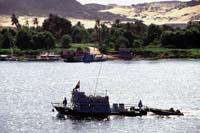The Asuan dam to the detriment of the environment

The Great Dam of Aswan is really big: It is 111 meters high, almost a kilometer wide and 2,325 meters long. And let's not say the reservoir that generates the dam, which along the Nile has about 500 km of length and 6.000 km 2 of surface. The Great Aswan Dam is located in Egypt, 800 km south of Cairo, but the reservoir is not exclusive to Egypt, the third is from Sudan. Therefore, the lake is called Nasser for the Egyptians and Nubia for the Sudanese.
This large dam was built to control flooding, increase irrigation surface and produce hydroelectric power. But in addition to these advantages, it has had a great environmental impact.
Increasingly poor soil
The Nile River suffered a sharp drop in flow due to the Aswan dam and, along with the water, the sediments remain at the bottom of the lake. Previously, Nile transported about 124 million tons of sediments per year, of which it left about 10 million tons in the flood plain. However, from the Aswan Dam, 89% of these sediments are found in Lake Nasser, which has reduced fertility and depth of the flood plain. To cope with this impact, farmers emit artificial fertilizers that previously did not use soils, that salinize the soil and pollute the Nile water with the return of flood waters.
In addition, the lack of sediments has caused the delta to stop progressing, breaking the previous balance. The sea is eating land to the coast and that also helps to salt the land.
And all this aggravated by the desertive climate. The water of Lake Nasser is increasingly salty, as it evaporates a lot, so its influence on irrigation is evident. Certainly, salinity has become a major problem in Egypt. According to 1999 data, 35% of Egyptian soils presented salinity problems.

Fishing decline
In addition to the land, the sea has suffered the consequences of the Asuan dam. The Mediterranean is an oligotrophic sea, that is, little nutrient and therefore little biodiversity. This small production is a consequence of several factors, but the greatest influence is the marine currents. The surface current west-east direction leads to the waters of the north Atlantic through the Strait of Gibraltar, waters with few nutrients. This current also produces an opposite flow, that is, it channels the most nutrient-rich seabed water into the Atlantic.
However, there are also more fertile areas, as is the case or, above all, the area near the mouth of the Nile. Before the dam, 50% of the Nile waters poured into the sea. At flood times, an average of 5,000 tons of phosphates and 280,000 tons of silicates were thrown into the sea. Their influence on the sea was evident: they grew large densities of phytoplankton in front of the delta, which are a source of food for many living beings.
Flood waters stretched 15 km along the Egyptian coast to the shores of Israel, sometimes reaching southern Turkey. The Great Dam of Aswan, however, has made flood waters much poorer and, consequently, the southeast Mediterranean has also become impoverished.
Just look at the catches. In 1962 and 1963 they went from 35,000 tons to 8,000 tons in 1969. Perhaps the most representative is the decrease in the capture of the sardine, especially of the Sardinella aurita, a species very dependent on the phytoplankton emerged during the floods. In 1962 18,000 tons of sardines were captured, while in 1968 and 1969 460 and 600 tons were captured respectively. Izki fishing also went down a lot. In 1963 8,300 tons of shrimp were captured and in 1969 1,128 tons.

Reservoir management
However, the problems associated with the reservoir are not outside the reservoir. The management of the reservoir itself generates a series of headaches. Lake Nasser is being filled with sediments, so this is a limited term project.
But that is not the only concern, has anyone thought what a catastrophe can mean? The risks of seismic destabilization are being investigated in recent years. The weight of the reservoir can cause underground movements that can affect the safety of the reservoir itself. If the Aswan reservoir was broken, 162,000 cubic meters of water from the reservoir would cause a terrible disaster in the area, and the 11 million inhabitants of Cairo would be flooded from time to time.





